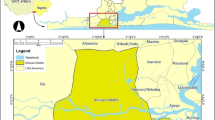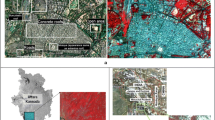Abstract
Direct applications of remote sensing thermal infrared (TIR) data in landscape ecological research are rare due to limitations in the sensors, calibration, and difficulty in interpretation. Currently there is a general lack of methodology for examining the relationship between land surface temperatures (LST) derived from TIR data and landscape patterns extracted from optical sensors. A separation of landscapes into values directly related to their scale and signature is a key step. In this study, a Landsat ETM+ image of Indianapolis, Unites States, acquired on June 22, 2000, was spectrally unmixed (using spectral mixture analysis, SMA) into fraction endmembers of green vegetation, soil, high albedo, and low albedo. Impervious surface was then computed from the high and low albedo images. A hybrid classification procedure was developed to classify the fraction images into seven land use and land cover (LULC) classes. Using the fractional images, the landscape composition and pattern were examined. Next, pixel-based LST measurements were correlated with the landscape fractional components to investigate LULC based relationships between LST and impervious surface and green vegetation fractions. An examination of the relationship between the LULC and LST maps with landscape metrics was finally conducted to deepen understanding of their interactions. Results indicate that SMA-derived fraction images were effective for quantifying the urban morphology and for providing reliable measurements of biophysical variables. LST was found to be positively correlated with impervious surface fraction but negatively correlated with green vegetation fraction. Each temperature zone was associated with a dominant LULC category. Further research should be directed to the theoretical and applied implications of describing such relationships between LULC patterns and urban thermal conditions.




Similar content being viewed by others
Notes
Landsat 7 Senior Systems Engineer, Landsat Project Science Office, Goddard Space Flight Center, Washington, D.C.
References
Adams JB, Sabol DE, Kapos V, Filho RA, Roberts DA, Smith MO, Gillespie AR (1995) Classification of multispectral images based on fractions of endmembers: application to land cover change in the Brazilian Amazon. Remote Sens Environ 52:137–154
Alberti M, Marzluff J (2004) Ecological resilience in urban ecosystems: linking urban patterns to ecological and human function. Urban Ecosyst 7(3):241–265
Byrne GF (1979) Remotely sensed land cover temperature and soil water status - a brief review. Remote Sens Environ 8:291–305
Carlson TN, Gillies RR, Perry EM (1994) A method to make use of thermal infrared temperature and NDVI measurements to infer surface soil water content and fractional vegetation cover. Remote Sens Rev 9:161–173
Clapham WB Jr (2003) Continuum-based classification of remotely sensed imagery to describe urban sprawl on a watershed scale. Remote Sens Environ 86:322–340
Conway TG (1997) Improved remote heat sensing. Mech Eng 119(5):88–89
Frohn RC (1998) Remote sensing for landscape ecology. Lewis, Boca Raton, FL
Gallo KP, Owen TW (1998) Assessment of urban heat island: a multi-sensor perspective for the Dallas-Ft. Worth, USA region. Geocarto Int 13:35–41
Gillies RR, Carlson TN (1995) Thermal remote sensing of surface soil water content with partial vegetation cover for incorporation into climate models. J Appl Meteorol 34:745–756
Gillies RR, Carlson TN, Cui J, Kustas WP, Humes KS (1997) A verification of the ‘triangle’ method for obtaining surface soil water content and energy fluxes from remote measurements of the Normalized Difference Vegetation index (NDVI) and surface radiant temperature. Int J Remote Sens 18:3145–3166
Goward SN (1981) Thermal behavior or urban landscapes and the urban heat island. Phys Geogr 1(2):19–33
Goward SN, Xue Y, Czajkowski KP (2002) Evaluating land surface moisture conditions from the remotely sensed temperature/vegetation index measurements: an exploration with the simplified simple biosphere model. Remote Sens Environ 79:225–242
Gustafson EJ (1998) Quantifying landscape spatial pattern: what is the state of the art? Ecosystems 1:143–156
Hunsaker CT, O’Neill RV, Jackson BL, Timmins SP, Levine DA, Norton DJ (1994) Sampling to characterize landscape pattern. Landsc Ecol 9(3):207–226
Jenks M, Burton E, Williams K (eds) (1996) The compact city: a sustainable urban form?, pp 13–35. E & FN Spon, and imprint of Chapman and Hall, London
Lo CP, Quattrochi DA, Luvall JC (1997) Application of high-resolution thermal infrared remote sensing and GIS to assess the urban heat island effect. Int J Remote Sens 18:287–304
Lu D, Weng Q (2004) Spectral mixture analysis of the urban landscapes in Indianapolis with Landsat ETM+ imagery. Photogramm Eng Remote Sensing 70(9):1053–1062
Lu D, Weng Q (2006) Use of impervious surface in urban land use classification. Remote Sens Environ 102(1–2):146–160
Lynch K (1981) Good City form. MIT, Cambridge, MA
Machlis GE, Force JE, Burch WR Jr (1997) The human ecosystem part I: the human ecosystem as an organizing concept in ecosystem management. Soc Nat Resour 10:347–367
Madhavan BB, Kubo S, Kurisaki N, Sivakumar TVLN (2001) Appraising the anatomy and spatial growth of the Bangkok Metropolitan area using a vegetation-impervious-soil model through remote sensing. Int J Remote Sens 22:789–806
McGarigal K, Marks BJ (1995) FRAGSTATS: spatial pattern analysis program for quantifying landscape structure. General Technical Report PNW-GTR-351, USDA Forest Service, Pacific Northwest Research Station, Portland, OR
McGarigal K, Cushman SA, Neel MC, Ene E (2002) FRAGSTATS: Spatial Pattern Analysis Program For Categorical Maps. Computer software program produced by the authors at the University of Massachusetts, Amherst. URL: http://www.umass.edu/landeco/research/fragstats/fragstats.html (Last date accessed: 10 May 2005)
Nichol JE (1994) A GIS-based approach to microclimate monitoring in Singapore’s high-rise housing estates. Photogramm Eng Remote Sensing 60:1225–1232.
Nichol JE (1996) High-resolution surface temperature patterns related to urban morphology in a tropical city: a satellite-based study. J Appl Meteorol 35:135–146
Oke TR (1982) The energetic basis of the urban heat island. Q J R Meteorol Soc 108:1–24
O’Neill RV, Krummel JR, Gardner RH, Sugihara G, Jackson B, DeAngelis DL, Milne BT, Turner MG, Zygmunt B, Christensen SW, Dale VH, Graham RL (1988) Indices of landscape pattern. Landsc Ecol 1:153–162
Owen TW, Carlson TN, Gillies RR (1998) An assessment of satellite remotely-sensed land cover parameters in quantitatively describing the climatic effect of urbanization. Int J Remote Sens 19:1663–1681
Phinn S, Stanford M, Scarth P, Murray AT, Shyy PT (2002) Monitoring the composition of urban environments based on the Vegetation-Impervious Surface-Soil (VIS) model by subpixel analysis techniques. Int J Remote Sens 23:4131–4153
Pickett STA, Burch WR Jr, Dalton SE, Foresman TW, Grove JM, Rowntree RA (1997) A conceptual framework for the study of human ecosystems in urban areas. Urban Ecosyst 1:185–201
Quattrochi DA, Luvall JC (1999) Thermal infrared remote sensing for analysis of landscape ecological process: methods and applications. Landsc Ecol 14:577–598
Rashed T, Weeks JR, Gadalla MS, Hill AG (2001) Revealing the anatomy of cities through spectral mixture analysis of multisepctral satellite imagery: a case study of the Greater Cairo region, Egypt. Geocarto Int 16:5–15
Ridd MK (1995) Exploring a V-I-S (Vegetation-Impervious Surface-Soil) model for urban ecosystem analysis through remote sensing: comparative anatomy for cities. Int J Remote Sens 16:2165–2185
Riitters KH, O’Neill RV, Hunsaker CT, Wickhan JD, Yankee DH, Timmins SP, Jones KB, Jackson BL (1995) A factor analysis of landscape pattern and structure metrics. Landsc Ecol 10:23–39
Roberts DA, Batista GT, Pereira JLG, Waller EK, Nelson BW (1998) Change identification using multitemporal spectral mixture analysis: applications in eastern Amazônia. In: Lunetta RS, Elvidge CD (eds) Remote sensing change detection: Environmental monitoring methods and applications. Ann Arbor Press, Ann Arbor, MI, pp 137–161
Roth M, Oke TR, Emery WJ (1989) Satellite derived urban heat islands from three coastal cities and the utilisation of such data in urban climatology. Int J Remote Sens 10:1699–1720
Saunders D, Hobbs RJ, Margules CR (1991) Biological consequences of ecosystem fragmentation: a review. Conserv Biol 5:18–32
Schmid HP (1988) Spatial scales of sensible heat flux variability: representativeness of flux measurements and surface layer structure over suburban terrain. Ph.D. Thesis, The Univesity of British Columbia, Vancouver, BC
Small C (2001) Estimation of urban vegetation abundance by spectral mixture analysis. Int J Remote Sens 22:1305–1334
Smith RM (1986) Comparing traditional methods for selecting class intervals on choropleth maps. Prof Geogr 38(1):62–67
Soil Conservation Service (1975) Urban hydrology for small watersheds, USDA Soil Conservation Service Technical Release No. 55. Washington, DC
Turner MG (1989) Landscape ecology: the effect of pattern on process. Ann Rev Ecolog Syst 20:171–197
Turner MG (1990) Spatial and temporal analysis of landscape patterns. Landsc Ecol 4:21–30
Voogt JA, Oke TR (1998) Effects of urban surface geometry on remotely-sensed surface temperature. Int J Remote Sens 19:895–920
Voogt JA, Oke TR (2003) Thermal remote sensing of urban climate. Remote Sens Environ 86:370–384
Wang YQ, Zhang X, Liu H, Harari-Kremer R (1999) Landscape characterization of metropolitan Chicago region by Landsat TM. In: Proceedings of American Society for Photogrammetry and Remote Sensing, pp 238–247
Ward D, Phinn SR, Murray AL (2000) Monitoring growth in rapidly urbanizing areas using remotely sensed data. Prof Geogr 53:371–386
Weng Q (2001) A remote sensing-GIS evaluation of urban expansion and its impact on surface temperature in the Zhujiang Delta, China. Int J Remote Sens 22:1999–2014
Weng Q, Lu D, Schubring J (2004) Estimation of land surface temperature–vegetation abundance relationship for urban heat island studies. Remote Sens Environ 89(4):467–483
Wilson JS, Clay M, Martin E, Stuckey D, Vedder-Risch K (2003) Evaluating environmental influences of zoning in urban ecosystems with remote sensing. Remote Sens Environ 86:303–321
Wu C, Murray AT (2003) Estimating impervious surface distribution by spectral mixture analysis. Remote Sens Environ 84:493–505
Wu J, Jelinski DE, Luck M, Tueller PT (2000) Multiscale analysis of landscape heterogeneity: scale variance and pattern metrics. Geogr Inf Sci 6(1):6–19
Yang S, Zhang M, Zeng R (1984) The urban heat island effect of Guangzhou. Journal of South China Normal University 1984(2):35–45, (In Chinese with English summary).
Acknowledgments
This research is supported by National Science Foundation (BCS-0521734) for a project entitled “Role of Urban Canopy Composition and Structure in Determining Heat Islands: A Synthesis of Remote Sensing and Landscape Ecology Approach”. We would also like to thank Associate Editor, Dr. Gordon M. Heisler, and three anonymous reviewers for their constructive comments and suggestions.
Author information
Authors and Affiliations
Corresponding author
Rights and permissions
About this article
Cite this article
Weng, Q., Liu, H. & Lu, D. Assessing the effects of land use and land cover patterns on thermal conditions using landscape metrics in city of Indianapolis, United States. Urban Ecosyst 10, 203–219 (2007). https://doi.org/10.1007/s11252-007-0020-0
Received:
Accepted:
Published:
Issue Date:
DOI: https://doi.org/10.1007/s11252-007-0020-0




